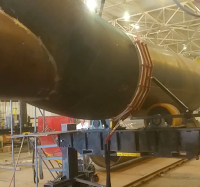Welding is the most common way of permanently joining metal parts. In this process, heat is applied to metal pieces, melting and fusing them to form a permanent bond. Because of its strength, welding is used in shipbuilding, automobile manufacturing and repair, aerospace applications, and thousands of other manufacturing activities. Welding also is used to join steel beams in the construction of buildings, bridges, and other structures and to join pipes in pipelines, power plants, and refineries.
Welders work in a wide variety of industries, from car racing to manufacturing. The work that welders do and the equipment they use vary with the industry. Arc welding, the most common type of welding today, uses electrical currents to create heat and bond metals together—but there are more than 100 different processes that a welder can use. The type of weld normally is determined by the types of metals being joined and the conditions under which the welding is to take place.
Welders, cutters, solderers, and brazers typically do the following:
- Study blueprints, sketches, or specifications
- Calculate dimensions to be welded
- Inspect structures or materials to be welded
- Ignite torches or start power supplies
- Monitor the welding process to avoid overheating
- Maintain equipment and machinery
PAY
The median annual wage for welders, cutters, solderers, and brazers was $39,390 in May 2016. The median wage is the wage at which half the workers in an occupation earned more than that amount and half earned less. The lowest 10 percent earned less than $26,800, and the highest 10 percent earned more than $62,100.
In May 2016, the median annual wages for welders, cutters, solderers, and brazers in the top industries in which they worked were as follows:
- Specialty trade contractors - $42,900
- Repair and maintenance - $39,340
- Manufacturing - $38,200
- Merchant wholesalers, durable goods - $37,790
Wages for welders, cutters, solderers, and brazers vary with the worker’s experience and skill level, the industry, and the size of the company.
Most welders, cutters, solderers, and brazers work full time, and overtime is common. Many manufacturing firms have two or three 8- to 12-hour shifts each day, allowing the firm to continue production around the clock if needed. As a result, welders, cutters, solderers, and brazers may work evenings and weekends.







